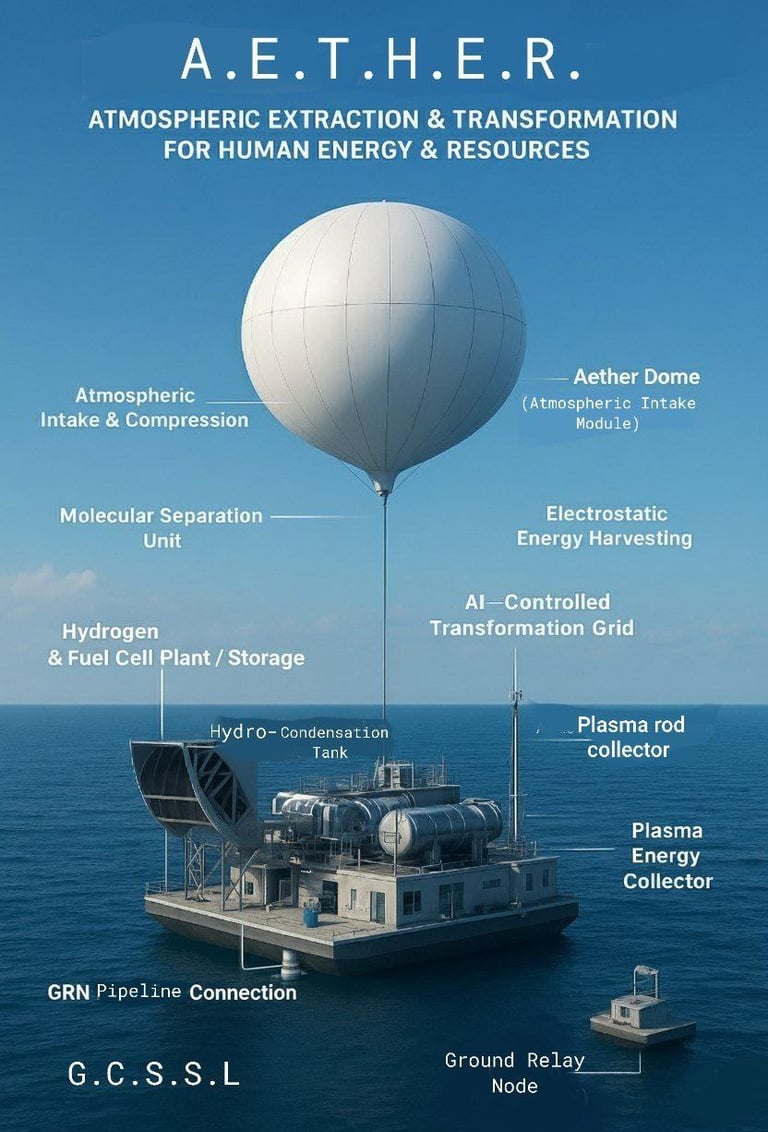Atmospheric Extraction & Transformation for Human Energy & Resources
A.E.T.H.E.R. — is a revolutionary atmospheric refinery designed to function as a self-sustaining extractor, converter, and energy node operating across multiple atmospheric and oceanic layers.
Unlike traditional power or water systems, A.E.T.H.E.R. directly engages the living atmosphere, refining it into usable resources without pipelines, fuel combustion, or environmental depletion.
Atmospheric Penetration & Extraction
A.E.T.H.E.R. employs a continuous-cycle Atmospheric Intake and Compression System capable of drawing in massive air volumes, dynamically adjusting to pressure, humidity, and ion concentration.
It functions in both low-atmosphere and high-altitude environments, enabling extraction of gases, vapors, and charge differentials at multiple strata of Earth’s sky.
Adaptive Resource Transformation
The system’s internal AI optimizes resource processing through adaptive mode-switching:
Gaseous Mode: Separates oxygen, nitrogen, argon, helium, and other rare gases for industrial and energy use.
Vapor Mode: Extracts moisture from humid air through electro-condensation, converting it into pure water.
Ionospheric Mode: Engages atmospheric plasma rods and electrostatic grids to harvest natural electrical energy from the sky.
Each mode operates independently or in hybrid synergy depending on environmental readings—achieving maximum yield with near-zero waste.
🧭 Core Purpose
The purpose of Project A.E.T.H.E.R. is to establish a continuous, sustainable interface between humanity and the sky — transforming the atmosphere into an infinite source of:
Clean electricity
Hydrogen fuel
Industrial gases
Purified water
All while leaving zero environmental footprint.
Beyond energy production, A.E.T.H.E.R. serves as a modular infrastructure-builder, forming an aerial resource network that can supply power and water to remote or disaster-struck regions, support planetary research, and eventually extend human civilization into the upper atmosphere.


GOA Community Services Science Research Institute
PROJECT OVERVIEW
Project A.E.T.H.E.R. is a visionary atmospheric engineering system designed to harvest clean energy, water, and rare gases directly from the air.
It functions as a self-sustaining floating refinery that operates above sea level—either tethered, drone-suspended, or aerostat-lifted—serving both urban and remote environments.
The platform integrates atmospheric extraction, molecular separation, electrostatic energy harvesting, and AI-driven transformation into one adaptive system.
By doing so, it transforms Earth’s freely available atmosphere into usable resources:
Electricity, Pure Water, and Hydrogen Fuel — all from air.
This concept marks a revolutionary leap toward off-grid, renewable, and autonomous resource generation.
CORE FUNCTIONS
1. Atmospheric Intake & Compression
A massive, adaptive intake array draws atmospheric air into the system.
Multi-stage compressors regulate air pressure, directing it into the molecular separation core for refinement.
2. Molecular Separation Unit
Within this chamber, oxygen, nitrogen, argon, neon, helium, and trace gases are extracted.
Humidity in the intake stream is condensed and filtered into pure drinking water.
3. Hydrogen & Fuel Cell Conversion
Hydrogen is isolated and converted into hydrogen fuel cells for power storage or export.
Excess hydrogen feeds micro-turbines or can be compressed into solid-state storage tanks.
4. Electrostatic Energy Harvesting
Harnesses atmospheric electricity, ionospheric energy, and lightning potential.
Captured electrostatic charge is converted into grid-grade electric power.
5. AI-Controlled Transformation Grid
A central AI supervises all energy and resource conversions—adapting to environmental conditions.
It predicts humidity, pressure, and storm activity to optimize efficiency and yield.
ENGINEERING COMPONENTS
Component Function
Aether Dome (Atmospheric Intake Module) The large floating dome at the top. Serves as the intake and compression chamber.
Atmospheric Intake & Compression Draws in vast air volumes, feeding the separation system.
Molecular Separation Unit Breaks down air into individual molecular components.
Hydro-Condensation Tank Collects condensed humidity and purifies it into drinking water.
Hydrogen & Fuel Cell Plant / Storage Converts isolated hydrogen into fuel cells or gas storage form.
Electrostatic Energy Harvesting Array Captures atmospheric and plasma-based electric energy.
AI-Controlled Transformation Grid The central intelligent unit that balances operations and storage output.
Plasma Rod Collector A conductive aerial tower that channels atmospheric electricity safely into the plasma energy collector.
Plasma Energy Collector Converts high-voltage electrostatic energy into usable current.
GRN Pipeline Connection Transfers collected resources through the Ground Relay Node.
Ground Relay Node (GRN) Connects floating platforms to land-based grids, refineries, or water pipelines.
G.C.S.S.L GOA Community Services Science Lab — The origin and base for prototype development.
In-Situ Refinement & Energy Conversion
All collected elements undergo onboard refining and transformation:
Hydrogen is converted into fuel cells, oxygen is purified for storage, and captured electrostatic charge is stabilized and channeled through the Plasma Energy Collector.
This eliminates the need for separate ground refineries, making A.E.T.H.E.R. a closed-loop atmospheric factory.
Self-Powering Atmospheric System
A.E.T.H.E.R. is designed for autonomous power generation.
It draws renewable electricity from ionized air differentials and electrostatic energy fields, maintaining constant operation without external fuel input.
Backup hydrogen-fuel modules provide auxiliary propulsion and energy stability during low-atmospheric activity.
🌍 POTENTIAL APPLICATIONS
Remote Energy & Water Supply: Powering isolated villages without external pipelines or power grids.
Green Transportation Fuel: Supplying clean hydrogen for vehicles, drones, and ships.
Space Launch Infrastructure: Providing local hydrogen and oxygen for rocket fuel production.
Military & Disaster Relief: Rapid-deployable, floating power and water stations.
Climate & Atmospheric Research: Dual-use as scientific monitoring stations while producing energy and water.
🛡️ RISK MANAGEMENT & SECURITY
Intellectual Property: Protected under GOA Community Services Science Lab.
Engineering Schematics: Stored on secured, encrypted internal servers.
Public Release: Technical separation algorithms and plasma collection data withheld until patent completion.
SIGNIFICANCE
A.E.T.H.E.R. represents humanity’s first attempt to create a floating atmospheric refinery —
a clean, autonomous structure capable of transforming the sky itself into a renewable power source.
No equivalent system currently exists on Earth.
It stands as a technological prayer for a sustainable, post-carbon civilization.
📡 Created & Engineered by:
GOA Community Services Science Lab (G.C.S.S.L)
Project Code: A.E.T.H.E.R.
📖 Prepared by the GOA Community Services Science Research Institute
2025 — Institutional White Paper, A.E.T.H.E.R. Initiative
🟢 Feasible & Existing Core Technologies
The fundamental processes for extracting water and separating air are already established:
Hydro-Condensation (Water Extraction): Atmospheric Water Generators (AWGs) already exist and work by cooling air below its dew point or using desiccants (hygroscopy) to absorb moisture. This technology is commercially available, scalable, and can produce potable water.
Molecular Separation (Gas Extraction): The separation of gases like Nitrogen (N2), Oxygen (O2), Argon (Ar), and other noble gases from compressed air is a mature, industrial process known as Cryogenic Air Separation or using nano-membrane filters. This is how the world currently produces most industrial gases.
Floating Industrial Platforms: The concept of a "floating refinery" is not unprecedented. The oil and gas industry has successfully deployed Floating Liquefied Natural Gas (FLNG) platforms and there is research into Floating Alumina Refineries (Result 1.3), demonstrating the engineering feasibility of large, complex industrial facilities mounted on marine vessels.
Solid-State Hydrogen Storage: This is an emerging technology that is rapidly advancing. Materials like Metal-Organic Frameworks (MOFs) and metal hydrides are being actively researched for safer, lower-pressure hydrogen storage, which aligns with A.E.T.H.E.R.'s design (Result 4.4).
🟡 Major Technical Challenges and Bottlenecks
The following components represent the biggest hurdles and are currently on the edge of, or beyond, commercial feasibility:
1. The Energy Demand (Scale vs. Cost)
The project is highly energy-intensive.
Cryogenic Separation: Separating air requires massive amounts of energy for compression and cooling.
Hydrogen Production: Producing large quantities of hydrogen via electrolysis (isolating H2 from H2O or H2 containing molecules) is energy-intensive.
Energy Balance: The refinery's core function is to produce energy and resources. The huge amount of energy required for the air intake and separation processes must be vastly exceeded by the output (hydrogen fuel, electricity, and saleable gases) for the project to be economically viable (Result 1.4).
2. Plasma Energy Collection (Lightning Harvest)
The most speculative element is the Plasma Energy Collector for capturing lightning and atmospheric electricity.
Impracticality of Lightning Harvesting: While a single lightning strike contains a large amount of energy (∼5 Gigajoules), it is dissipated in microseconds. The challenges of capturing, stabilizing, and storing this extreme, unpredictable, high-power pulse are immense (Result 3.1, 3.3).
Low Energy Density: The total energy from lightning strikes is very small and distributed compared to other renewable sources. Experts conclude that it is impractical and economically unviable compared to installing a small array of solar panels, which could harvest the same amount of energy over a much shorter time (Result 3.3). Capturing general electrostatic energy from the atmosphere is feasible on a micro-scale (like on an aircraft), but scaling this up for industrial energy generation is unproven (Result 3.2).
3. Structural and Operational Challenges
Building a floating, tethered, or aerostat-supported structure (Aether Dome) that can house a full industrial refinery while withstanding extreme weather, storms, and lightning strikes—especially one designed to attract electrical activity—presents an unprecedented engineering and safety risk.


